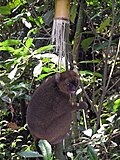Lemur
Lemurs are primates and prosimians (not monkeys). The word "lemur" comes from the Latin word lemures, which means "ghosts". Lemur are divided into eight families, with 15 genera and about 100 living species. However, lemur classification is controversial: it depends on which species concept is used. Lemur is also a genus in one of the families.[1]
| Lemurs | |
|---|---|

| |
| Ring-tailed lemur (Lemur catta) carrying twins | |
| Scientific classification | |
| Kingdom: | |
| Phylum: | |
| Class: | |
| Order: | |
| Suborder: | |
| Infraorder: | Lemuriformes Gray, 1821
|
| Superfamilies | |
Lemurs are native only to the island of Madagascar. From there a few species got to smaller islands nearby, for example the Comoros. Madagascar, like Africa and India, was part of the ancient southern continent of Gondwana.[2]
Lemurs weigh from 30g to the 10kg. Larger species have all become extinct since human groups moved to Madagascar. Usually, the smaller lemurs are active at night (nocturnal), and the larger ones were active during the day (diurnal).
Lemurs are endangered species because people destroy their habitat and used to hunt them, and perhaps still do so.
Physical description
Ring-tailed lemur, the most studied, are white and black with a ring tail[3] The larger species are about 1.5 meters tall and weigh about 2 to 3.5 kilograms. They move quietly, usually at night, sometimes letting out eerie wailing cries, which some people think is the reason why they got their names.
Feeding habits and life
Lemurs mostly eat fruit, leaves, and other plant parts. They live in family groups of 5 to 42 members which is called a troop. Females are dominant and remain in the same troop for life. Males move between troops. The female's gestation period lasts four to five months, and they usually have one or two babies. Lemur mothers nurse their babies until they are about four months old. Then they begin to feed the babies solid food such as fruit. Lemurs spend most of their time in the trees. Some are great leapers, flinging themselves from tree to tree.[4]
Communication
Lemurs communicate with a variety of hoots. They will also send messages with scents (smells). When a male lemur wants to scare another male away, he first rubs its tail on the smelly glands under its arms and then waves the tail in the other male's face. These are called "stink fights".
Lemur Media
A life restoration of Babakotia radofilai, a sloth lemur that became extinct less than two thousand years ago
The Sahamalaza sportive lemur (Lepilemur sahamalazensis) was identified as a distinct species in 2006.
Close-up of a ruffed lemur's foot, showing the toilet-claw on the second toe and nails on all other toes
A six-tooth version of the strepsirrhine toothcomb in a ring-tailed lemur, with canine-like premolars behind it
Lemurs generally have a wet nose, or rhinarium, as well as a longer snout than anthropoid primates.
Aye-ayes exhibit eyeshine because they have a reflective layer of tissue in the eye, called a tapetum lucidum.
Mouse lemurs primarily eat fruit, although their diet also includes insects.
Up to 95% of the greater bamboo lemur's diet consists of bamboo.Template:LoM2 Sfn
Dwarf lemurs are solitary but social, foraging alone but often sleeping in groups.
Related pages
References
- ↑ Garbutt N. 2007. Mammals of Madagascar: a complete guide. A&C Black Publishers. ISBN 978-0-300-12550-4
- ↑ Goodman S.M. & Benstead, J.P. (eds) 2003. The Natural History of Madagascar. University of Chicago Press. ISBN 978-0-226-30306-2
- ↑ "Ring-tailed Lemur".
- ↑ Mittermeier R.A. et al 1994. Lemurs of Madagascar. Illustrated by S.D. Nash. Conservation International. ISBN 1-881173-08-9
Other websites
| Wikimedia Commons has media related to Lua error in Module:Commons_link at line 62: attempt to index field 'wikibase' (a nil value).. |
| Wikispecies has information on: Lemur. |
- Lemurs of the East Coast of Madagascar Archived 2006-05-13 at the Wayback Machine
- New lemurs found in Madagascar
- Great leaping lemurs Archived 2005-02-13 at the Wayback Machine









